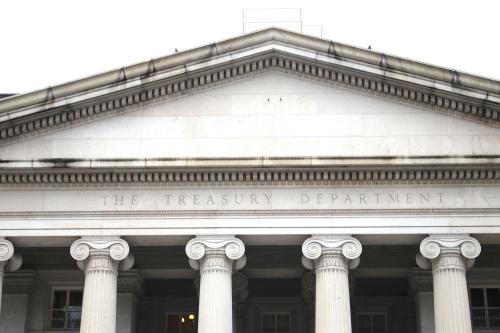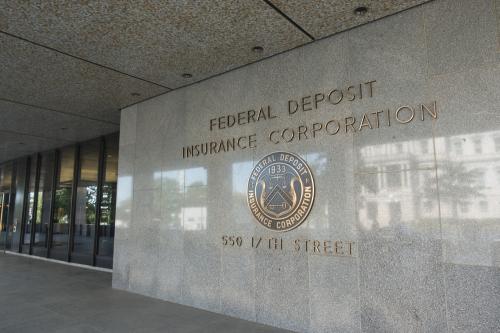This is an edited version of remarks Don Kohn delivered at the Federal Reserve’s conference, “Integrated review of the capital framework for large banks,” on July 22, 2025.
The Supplementary Leverage Ratio (SLR) is a bank capital requirement that applies the same capital to all bank assets, whatever their risk. The leverage ratio is an important and necessary component of bank capital regulation. It is available as the primary capital constraint for smaller banks whose ability to model and monitor risk-based capital might be challenging and unnecessarily expensive. And, appropriately calibrated, it will usefully serve as a backstop to risk-based capital requirements for larger banks; we know from experience that assets can turn out to be much riskier than they are modeled, with AAA tranches of mortgage-backed securities as Exhibit A.
When the leverage ratio is binding or potentially binding, however, it discourages purchases of low risk, low return assets, like U.S. government securities. I have long supported adjusting the SLR to be a backstop for larger banks so that it doesn’t inhibit the willingness of their dealers to intermediate and provide liquidity for the Treasury market. The bank regulatory agencies have published a proposal for adjusting the SLR that does this. In fact, it aligns with one suggestion made in a 2021 Brookings report from a task force on financial stability that I co-chaired, so I view the proposal favorably.
But my support for reducing the SLR has been accompanied by an important condition—that it not reduce overall capital requirements and the resiliency of the banking system. In this regard, the proposal would have only trivial effects on the capital requirements of the parent bank holding companies—and that is good. But I have a few concerns I hope are addressed at the conference today, and in the agencies’ consideration as they finalize the proposed rule.
First, obviously, making the SLR a backstop elevates the importance of the first line of defense of financial stability—sound risk-based capital requirements. Financial sector resilience is especially important right now. The economy could well be on track for decent growth with low inflation as is priced into financial markets, but we shouldn’t be complacent. Treasury Secretary Scott Bessent, in answering questions after his speech at this conference, noted concerns about the procyclicality that often plagues the financial sector, with standards relaxed in good times. He cited the recent rapid growth of private credit, but this has been a disease that also has been known to infect banks and their regulators.
Moreover, the tails of the distributions around the benign central tendency priced into markets seem unusually fat right now. We are in uncharted waters with respect to the evolution of the global trading system, to the ratio of federal debt to national income, and to challenges to the independence of the Fed. The risk of unanticipated developments in the economy and in the financial markets seems very high.
It would be far preferable to evaluate this proposal as part of a holistic review of all capital requirements, including the risk-based ones, and in that respect the comprehensive nature of this conference is very welcome. As the subsequent panels at the conference indicate, the Basel 3 end game and G-SIB capital requirements are in play, as well as the stress tests—how well they test resilience and how they fit into capital requirements. Were risk-based capital requirements weakened, I would need to rethink my support for reducing the SLR backstop. I urge the agencies to put the whole package together before signing off on one piece.
Second, while the proposal maintains capital at the holding company, it would release considerable capital at the depository institution subsidiaries. That will not reduce the resilience of the overall organization, but it will encourage banks to buy Treasury securities, exposing them to added interest rate risk. Embedded losses on Treasury and agency securities contributed to Silicon Valley Bank’s problems in March 2023, and similar losses in many other banks led to the potential spread of those problems, which triggered the extraordinary actions the authorities took to stabilize the banking system.
To guard against an increase in interest rate risk at banks, all banks should be required to mark to market securities in their Available for Sale portfolios and have those marks reflected in their regulatory capital, and the interest rate risk in those security holdings should be subject to market risk capital requirements. In addition, bank interest rate risk management, including for the securities in their Hold to Maturity portfolios, should be subject to close supervisory scrutiny. My concern about encouraging interest rate risk means I would not be in favor of exempting all Treasuries from the denominator of the SLR—an alternative about which the regulators’ proposal inquires —with the exception of the dealer trading book, which is marked to market and subject to market risk capital charges.
Finally, I would caution the authorities about reliance on the holding company as a source of strength to the bank in a systemic crisis. Once that capital is up streamed from the bank to the holding company and down streamed to the dealer to support Treasury market making, it will be difficult to reverse the flow when markets, banks, and asset prices are under stress. Our experience in the 2007-09 financial crisis was that capital more often needed to be up streamed from the bank to the holding company to support the broker-dealer subsidiary.
The Brookings Institution is committed to quality, independence, and impact.
We are supported by a diverse array of funders. In line with our values and policies, each Brookings publication represents the sole views of its author(s).







Commentary
Donald Kohn’s thoughts on supplementary leverage ratio reform
August 12, 2025